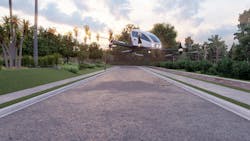NASA selects Mosaic ATM to develop signal strength toolkit for AAM aircraft
LEESBURG, Va., - The National Aeronautics and Space Administration (NASA) needed a new solution to utilize deep learning to predict signal strength at low altitude for an advanced air mobility (AAM) aircraft. They selected Mosaic ATM in Leesburg, Virginia, to develop that solution.
The machine learning system is trained using high-fidelity physics-based simulated data and actual data recorded from test flights. Using a combination of convolutional neural networks and deep learning systems, the accuracy of the estimation will be high, Mosiac says, with a speed that is about ten times faster than current physics-based algorithms, and will be applied to the low-altitude UAM communications system.
Mosaic ATM says its goal is to produce a quick and reliable signal strength estimate for an advanced air mobility vehicle within four minutes. The estimate will consider atmospheric effects, transmitter power, Doppler shifts, multipath interference, terrain obstructions, and many other effects. This tool is an example of training a machine 'earning system to understand physics, such as signal propagation. The applications include pre-flight planning, route contingency management, transmitter health status, transmitter location placement, and others.
The project’s Principal Investigator is Dr. Frederick Wieland, the Chief Research Scientist at Mosaic ATM. Mosaic ATM has provided services to NASA since the earliest days of Mosaic in 2004 through Small Business Innovative Research (SBIR) contracts and NASA Research Announcement (NRA) contracts.
